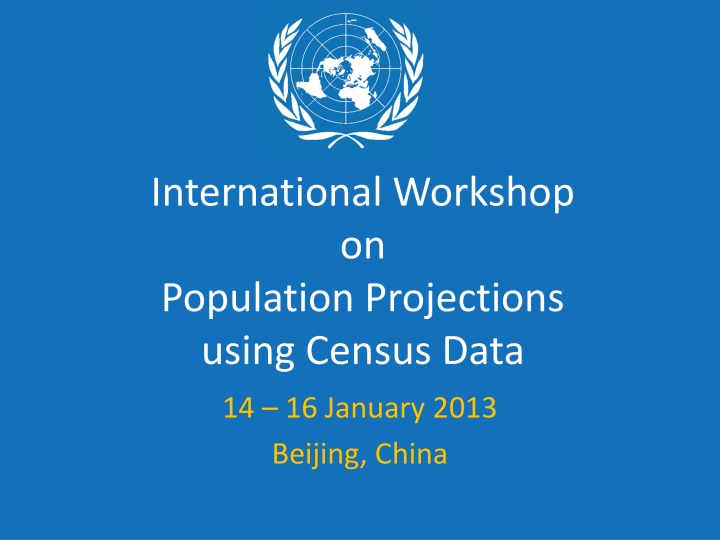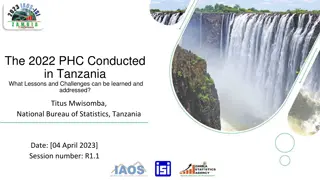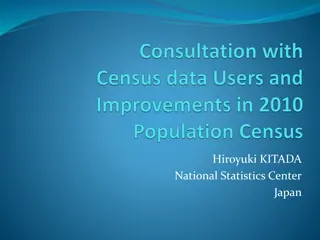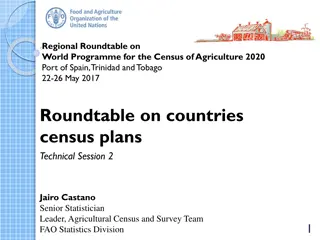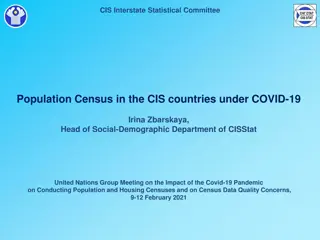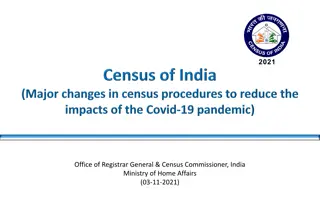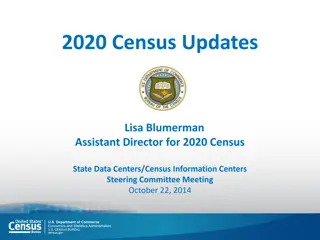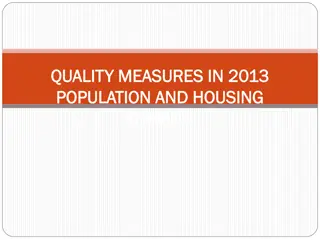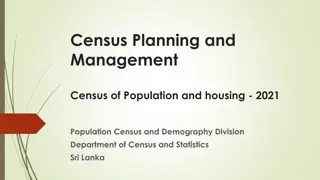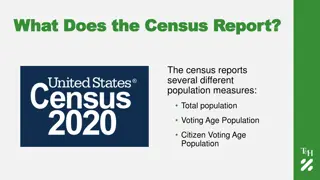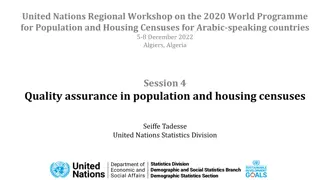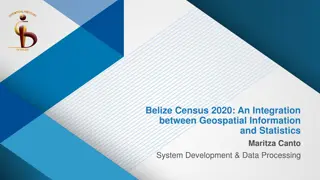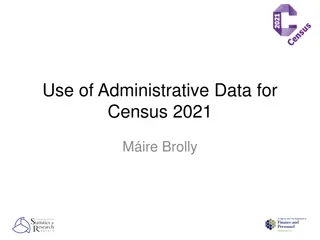International Workshop on Population Projections Using Census Data
This content provides insights into projecting age patterns of mortality, fertility, and migration based on census data gathered during an international workshop held in Beijing, China in January 2013. It covers various approaches to projecting mortality patterns and highlights life expectancy trends in African countries. Additionally, it includes information on age-specific mortality rates and life table survivors for males and females.
Download Presentation

Please find below an Image/Link to download the presentation.
The content on the website is provided AS IS for your information and personal use only. It may not be sold, licensed, or shared on other websites without obtaining consent from the author.If you encounter any issues during the download, it is possible that the publisher has removed the file from their server.
You are allowed to download the files provided on this website for personal or commercial use, subject to the condition that they are used lawfully. All files are the property of their respective owners.
The content on the website is provided AS IS for your information and personal use only. It may not be sold, licensed, or shared on other websites without obtaining consent from the author.
E N D
Presentation Transcript
International Workshop on Population Projections using Census Data 14 16 January 2013 Beijing, China
Session V: Projecting the age patterns of mortality, fertility, and migration Projecting age patterns of mortality Projecting age patterns of fertility Projecting age patterns of migration http://unstats.un.org/unsd/demographic/meetings/wshops/China2013/list_of_docs.htm
Projecting age patterns of mortality Overview
Projecting age patterns of mortality Two approaches: Project age patterns of mortality based on empirical trends. Level of mortality is implicit. Project age patterns of mortality based on established trends of the level of mortality and determine an associated age pattern based on models.
Life expectancy 2005-2010 The five African countries with the highest and the lowest life expectancy, 2005-2010 Rank Country Life expectancy at birth, bot sexes combined 1 2 3 4 5 R union Mayotte Libyan Arab Jamahiriya Tunisia Cape Verde 77.26 77.14 74.04 73.90 73.54 50 51 52 53 54 Guinea-Bissau Zimbabwe Sierra Leone Lesotho Central African Republic 46.76 46.59 46.26 46.02 45.91
Life table survivors, males Survivors to exact age (lx) per 100,000 live births, Males 100000 90000 80000 70000 60000 50000 40000 30000 20000 10000 0 0 10 20 30 40 50 60 70 80 90 100 Africa R union Central African Republic Japan
Life table survivors, female Survivors to exact age (lx) per 100,000 live births, Females 100000 90000 80000 70000 60000 50000 40000 30000 20000 10000 0 0 10 20 30 40 50 60 70 80 90 100 Africa R union Central African Republic Japan
Age specific mortality, males Age specific mortality rate by age (mx), Males 1 0.1 0.01 0.001 0.0001 0.00001 0 10 20 30 40 50 60 70 80 90 100 Africa R union Central African Republic
Age-specific mortality, females Age specific mortality rate by age (mx), Females 1 0.1 0.01 0.001 0.0001 0.00001 0 10 20 30 40 50 60 70 80 90 100 Africa R union Central African Republic
The impact of HIV/AIDS Botswana 2000-2005, males Suirvivor to exact age, Botswana 2000-2005 (males) 100000 90000 E0 65.8 80000 Loss of 17 years 70000 60000 50000 E0 48.8 40000 30000 20000 10000 0 0 10 20 30 40 50 60 70 80 90 100 AIDS NoAIDS
The impact of HIV/AIDS Botswana 2000-2005, males Life table deaths, Botswana 2000-2005 (males) 18000 16000 14000 12000 10000 8000 6000 4000 2000 0 0 10 20 30 40 50 60 70 80 90 100 AIDS NoAIDS
Projecting age patterns of mortality I: United Nation Model The software package MORTPAK from the United Nations provides a program MATCH , which generates model life tables. MORTPAK.[MATCH]. The original United Nations model for projecting age patterns of mortality has been documented, but not published as a user-friendly tool. See the new updated and extended United Nations model life tables : http://esa.un.org/unpd/wpp/Model-Life-Tables/download-page.html
Selection of reference life table Two scenarios: User-defined a life table Using a model life table
Projecting age patterns of mortality II: US Census Bureau Model The US Census Bureau has developed spreadsheets that interpolate life tables, one for each sex. The procedure interpolates between two pivotal life tables, based on the probabilities of dying n[nqx]: INTPLTM Interpolation for life tables for males INTPLTF Interpolation for life tables for females Usually, the pivotal life tables are a) An empirical life table for the base year of the projection b) An ultimate (upper limit) life table The spreadsheet generates a life table with a desired level of mortality that is between the life expectancies of the base and the ultimate life table. Repeated application of the procedure will generate a set of age-specific mortality rates [nmx] or probabilities of dying [nqx].
INTPLTM.xls/INTPLTF.xls Input data for INTPLTM/INTPLTF Table number [ Table 123 ] Country name and Year [ Poplandia: 1960 and 1980 ] Life expectancy at birth for life table 1 (base year) Life expectancy at birth for life table 2 (ultimate life table) Life expectancy at birth for desired life table Lower limit of open-ended age group Life expectancy for the open-ended age group, life table 1 Life expectancy for the open-ended age group, life table 2 Separation factor for age under 1, life table 1 Separation factor for age under 1, life table 2 Separation factor for ages 1-4, life table 1 Separation factor for ages 1-4, life table 1 Probabilities of dying by age nqx for life table 1 Probabilities of dying by age nqx for life table 2
Projecting age patterns of mortality III: US Census Bureau RUPEX The US Census Bureau s population projection program RUPEX has a built-in functionality that is similar to the spreadsheets INTPLTM and INTPLTF. The user needs to specify two pivotal life tables and, optionally, life expectancies for any year between the base and the last year of the projection. The projection program does the interpolation and adjustments automatically of the age-specific mortality values See on the companion CD: Arriaga (2012). Population Analysis with Microcomputers - Volume II - Extract B RUP.
Projecting age patterns of mortality IV: Spectrum Like RUPEX, Spectrum can generate internally age patterns of mortality based on trends of life expectancy and model life tables.
Hands-on exercise: Mortality patterns Make yourself familiar with the Excel templates and the MATCH [MORTPAK] package Use your national data for the exercise or use the test data from Session 4.
Projecting age patterns of fertility Overview
Projecting age patterns of fertility Approaches: Using characteristic empirical age patterns of fertility as a basis for projections. Interpolate between age patterns at the base period and a future target pattern.
Projecting age patterns of fertility I: United Nation Model Excel template UNPD_ASFR.xls Using characteristic age-patterns of fertility associated with select levels of fertility, the model generates a series of age patterns by interpolating between a base pattern and a target pattern. The template allows for extending the target pattern beyond the last year (target year) by keeping it constant.
ASFR vs. PASFR Don t forget that the UN model provides standardized age pattern, e.g. proportionate age-specific fertility rates. By multiplying each rate with the corresponding TFR, the ASFR are obtained.
Projecting age patterns of fertility II: US Census Bureau Model The model in spreadsheet ASFRPATT.xls finds age patterns of fertility for a give level of fertility, based on typical age-specific fertility patterns in developing countries.
ASFRPATT.xls COUNTRY: YEAR 1. Reported and Desired ASFR's 0.3500 0.3000 0.2500 0.2000 0.1500 0.1000 0.0500 0.0000 15-19 20-24 25-29 30-34 35-39 40-44 45-49 1970 2050
ASFRPATT.xls COUNTRY: YEAR 2. Reported and Desired ASFR Patterns = PASFR 0.4000 0.3500 0.3000 ASFR pattern (sum=1.0) 0.2500 0.2000 0.1500 0.1000 0.0500 0.0000 15-19 20-24 25-29 30-34 Age 35-39 40-44 45-49 1970 2050
Hands-on exercise: Fertility patterns Make yourself familiar with the Excel templates Use your national data for the exercise or use the test data from Session 4.
Projecting age patterns of migration Overview
Projecting age patterns of Migration I: United Nation Model Excel template UNPD_Migration Age Patterns.xlsm The model generates typical age patterns of migration for net-migration. The model estimates a typical sex ratio. The user may select one of three typical patterns.
Projecting age patterns of Migration I: United Nation Model Family migration Migration Levels by Age 0.30 0.25 5 Year Migration Rate 0.20 0.15 0.10 0.05 0.00 0-4 10-14 20-24 30-34 40-44 50-54 60-64 70-74 80+ Age Male Female
Projecting age patterns of Migration I: United Nation Model Male Labor Migration (immigration) Migration Levels by Age 0.30 0.25 5 Year Migration Rate 0.20 0.15 0.10 0.05 0.00 0-4 10-14 20-24 30-34 40-44 50-54 60-64 70-74 80+ Age Male Female
Projecting age patterns of Migration I: United Nation Model Female Labor Migration (immigration) Migration Levels by Age 0.30 0.25 5 Year Migration Rate 0.20 0.15 0.10 0.05 0.00 0-4 10-14 20-24 30-34 40-44 50-54 60-64 70-74 80+ Age Male Female
Hands-on exercise: Migration patterns Make yourself familiar with the Excel template Use your national data for the exercise or use the test data from Session 4.
